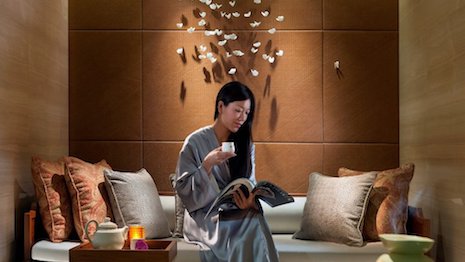As luxury marketers look to reach the valuable and growing population of Chinese outbound travelers, it is imperative for them to capture this segment's attention before they leave home since they are planners.
According to a new white paper from iClick, outbound Chinese tourists’ interest in foreign independent tours and customized itineraries is growing, reaching 42 percent compared to the 44 percent of traditional packaged tours. In addition, 52 percent of these travelers plan their trips and itineraries two to six months ahead of departure.
“The traditional style of market segmentation is not compatible with the current Chinese landscape," said Sammy Hsieh, CEO of iClick. "Based on iClick’s experience in the travel retail segment and our proprietary market intelligence platform, iAudience, we believe marketers need a more granular approach to effectively target this group.
“The findings from this report also demonstrate the powerful and extraordinary capabilities of our data, which can be leveraged by marketers from all sectors to generate insights specific to their industries," he said.
Chinese travelers
As these factors continue to grow, so do the profiles of the Chinese travelers.
The white paper states that while those from the top tier cities in China remain the biggest spenders while traveling, their interest in brand prominence and product quality is growing.
 Chinese travelers are growing in numbers. Image credit: Mandarin Oriental
Chinese travelers are growing in numbers. Image credit: Mandarin Oriental
Chinese millennials are also growing in the retail and travel landscape, but many marketers are using this group’s behavior as a model for all Chinese travelers. This mindset is to the detriment of the marketer.
IClick has categorized the Chinese traveler into three segments: the dark horse, the walking wallet and the awakened generation.
New affluents from the new first-tier cities make up the dark horse group, which primarily consists of males with disposable income to spend. The younger half of the group, aged 25 to 34, enjoy planning their trips themselves while those between the ages of 45 to 54 would rather purchase a packaged tour.
The walking wallet is categorized as one who enjoys spending on luxury items while overseas, who will account for 44 percent of the total global market by the year 2025. While the dark horse is mostly made of males, the walking wallet is mostly females, who are driven by material and spiritual aspects.
 Chinese actor Li Bingbing for Gucci. Image credit: Gucci
Chinese actor Li Bingbing for Gucci. Image credit: Gucci
These shoppers travel three to four times a year and will frequent certain luxury brands.
Chinese consumers born from 1990 to 1999 are the post '90s group, which iClick has dubbed the awakened generation. As the first generation of digital natives in China, most of what they do is manifested through their smartphones, which can be thought of as similar to a body organ.
Additional insight
The United States is becoming a highly coveted travel destination among affluent Chinese consumers, and due to their spending habits the demographic has proven extremely influential, according to a recent report from YouGov.
Chinese affluent look to purchase luxury goods while traveling abroad, and Chinese consumers spend the most out of any group while traveling. YouGov's Affluent Perspective 2017: Chinese Luxury Shoppers in America finds that 56 percent of Chinese affluent are planning a trip to the U.S. within the next two years (see story).
As Chinese consumers now account for 32 percent of spend on luxury goods worldwide, even luxury retailers in the United States need to focus on catering to them by understanding the culture and adopting mobile trends.
Speaking at the Luxury Marketing Forum, the CEO of Attract China detailed the importance of catering to affluent Chinese travelers, explaining China will be the top source of visitors in North America by the year 2020. These travelers spend an average of $7,200 per individual, likely reaching a total of $61.5 billion by 2020 (see story).
“We’re proud to have been chosen by iClick to publish this compelling thought leadership document,” said Martin Moodie, founder and chairman of The Moodie Davitt Report. “This white paper attempts to explore beyond the clichés, to consider not just the tourism and spending numbers and projections but to examine consumer dynamics, varying customer profiles and key behavioral components, including travel and shopping trends.”
{"ct":"DxrY4O5jIqnVYiHpRwuc5L3jA\/fhHTOhnmGrwv+DF1rN2oKcIJ\/c750ZvVcXU93q6t1KcD7dHeFW0W1dm0BQfCS8z5iUo8q9qzFAqpfzXK+ongCvPA8o1fWbmbuMaORPgmCpEzCHXVD60E95djJYUCn9GIFfD8G1XdKZBlvk6NTW0aN+G5S7fc4i0GO3rSTxaKCDLBjGDEYsvHPdDHTH3TzoNNfMxBIUst2RsZAhnnPde8N7sB28s1lYyy4TCKTioscXGwJs8TxlKm4vn6IBTxYI8fjsceojr1XDkrW2D3\/v1+NcmJHqosEcmHOZWF7SEmvV53aAaum5aeKkrrxEtquWItPCH2wJKFLtYFBJZwPHKhg+6jjeLh72uHAXmpuitBVxlC4ANAD3VyuxcYtsvVWVP5KOYLzUUNULtpXoFTGKBabFRrIWwe8K24fhziJ3+ovYGzWPICvMfsZf5fNWaCyZOOcLcy+M37zE5Yhkxssa0GxriEBHCoY9Dd3WR5t7wEu9koBd9oWLetgAsxx2opm8f0D7fJAjHJa55Gxg1Wrsw9MI3mLXe\/kQXP10rQTHlWmESU9VKOJhycM\/JilxEkEWB8LiyoDfEe4hsv3Y+j3HjzpYT4lBmzlqxP7CFf2eLBm7HJ+1aMYhVqssG4IVmADKGrU0QgP3+EfHov\/o07lEXOx9LyUJMkvo377dyECudMGVnoudDO9cxtDPTDADo26furHBeLKs3yTYLQje3ew7iio8mzYS4r0foq7Oek2cXCJD\/6opnkR9DvEVAnI7NzMJQGlzDt8euJHCWqtVNuooBMBvSIQd+wxpfoakEDxHSpimvSK\/ricd8ZCSk3GsW2fIO3qkkjMc4tdbUKDXZ0ILmP9OdphtCeH7Y9a9lg\/qiZDOzjBgXdLMC2x9kszvD8SPZ3SBzrxar\/h02r11e0fmt2Tu8pEY616P+DF44\/facTiSS4GySvgISH++oi8kkMBbW2btDHkZqGnxLXOe6aM+M59y4NUgLXW9B27SzDhAorrvwM3Ugo+L7oraMVGsU80WYIjFxLXy3xM2awerHZro252YTTWNTUn0DxtArnWq45d+Mdk51qwdKkfaVmND\/9eWW4\/Fl7p1UyV9Rs04IFxXC6hBYtm5ovV0zJAXTNr\/llE1s5mJWtAqpiICI5UVNbbkFEvSdLpIjEO+QANBhQ80TcfwAbYu4fsShPhWsCCZ5TNZDUSt99pKIrV1uISa1tNlxokx1kMACiFFIpVZq7gNlC1xX7tp1fC5+RAG9JWEajOlVSXt5x27+ZU6QbwrUH37D6enLGX0rbmD9s9mFVb\/uzuosCYAsSBxsbR2AJffXxe8Y7mgMBy3PxG5Q6D5F2fVMw1kbh1iH\/OuJxgOiQYHGpD0StCTUnjbx3ZMvUBmwszkLtrl84wQCl9ChIhf4DGWad6fx6c+ByKGtrNH7xWZ0K6RVhk6hm\/44NnF14AcN8pRPozywSdxobsQYwK7aDUjxA40XUcdvkSqgUArQfZLcvDgDZBQaLDqX8PNgShfsUCee6rwPFqpfJZ4w0FVo1E0BMoDS9EzucxzQdFlX89OT+xaKDJQ5rw9vJcRmaET2ZtgfmbSNR\/XJsEmnbTVJJ9hHSRoMtqHEEqfvMI6cTe6PdijoiOMkjTxec0wgizoihFcke+VAhQyuFdR5j4LPEUPf+eaWUSiu6DB0bjguaI9EcLLkEz2imCdjOZErYPUeV3seZoxnEtUUooFLbglbad\/TJq9Eagp1tLKl0+vZd3xcRm65\/PREzbJMo5lzq4QzMQWA2Qg+1brAwRG6Sf4rqM5lpaH4ArSG51uMNCcAIWeFPgDmHextp7BYZ3ya49I7+pEmObpO7cflTB2vcKCrPoagQfK0IIqzeMP+Y1h2bVCJZzysBqrhapfDa7sQww+7zIdkchM9rstQDpDsV49Wnid7nqKNaSMlP5zQD4Qxf\/C8UobNpoh3NuCKY8fc+DJeOR+Ju+G0PMzMzdFbTZQXg21l8H28HLiiXxuVlSIIwINZTWWAgNg0f9z2AjEeu2P3Ipm3xSQ6fsZe58KtFo6fkKG2LjkQRWF5IuHFDHbi5N3aX5h+IMPXlfE7orTZyKNr1X4GJ6lQUM7TPMIP1Z1rZ2aFDmNL3OlioX79gmU\/fp2hEu6AO5V69EyPxJW5Bh1xzvPSE3XLBi\/KmJW\/bb9X9sFqFP+64FGTtCzZBYfbcVI24xnwI5g5InwuS8fhiEr4U9g9CNjR3WqIMo1fW1OMn36g\/uRX2vSV3wsBTwokjjfww036iYgVuRmukZHbLIY+UTr5lywcytsXX+XjDDOLhRxFpa7TJwt60W3u12V+EXCZbS+Pxp080WDyGUBZVIKLVeg1Mbjscv7yhX3Nh5nQrKHXGlgEv38U7UZal35WsgMyciTw2FGviQjqrQvAETscwpgJujJKL7GPCdIEgExFZco+sQLthV8Ik\/lo9ItjhhegUJUKQj\/G+83NVmGWoXG2fwhLHTz67bafFMau7hdRpl1TrYeysHhFdgXk1NXkLPIjihlVGwxvzLVG4VojRucMJNLfr0MUZVjkIEZqa\/cQrWMLwnD7KXRn1+YcdWS85B9rItuyy6P1wFr\/Jizy7Crj448eP14eDOSgalunbkHd3LGLHakz+YhBh2fIlH7pQG8rqcYvJr7znf8\/QG2a4Roam7TDJZ3oSuXw9J95LZHrgVyRBwXeBIQoPAvgnz4rPTbJMg9KDdoXlUpgYeqsq4LLHnd3jQgaZgXVErH87L0wSsX4iGcNgLvhfSjKVHwJ7dOzN49lqCANW2j7\/3jnK8laeJY823+wUThCfa8p6KZaV5Kr7o\/IInScLwgzrefHkevBEEEePLkV23RROWHzlI4mBEiTYMTLUHV3UH5ttdEDjSfoEDpczte21G7bNOhw9kE2qPI0mzV21bJgFYKBxHwJuxNOgRyh2UirYZ+2PA3WCvc7WkwqQKZcD1\/+CvBkoUUNYE7NkryLenJCirkeO6CboU7UxebE3JaZNaZBlz1Sv9C\/qnfjTxgsl6XtRCVvUxDHmjxDq+JLKtxoMfyvV+QmRvNd4xuv30kxC8nQahbWatxQ9SKFNlYTHa1zTZXUQOoWUI+K1eYPiKxaQFLyXDZUQQr\/0af+0EecduF1\/PGi8DrBfJoJ5zpE\/nQa2ZKz4BnsMdOAdCS0pf1pWdM\/N2hxkosAsxyYjMcJemrn87ZRlDPHAKlS52OOvuwYzJfsE+5gcXwfm5jIXasYagjE72BZ+r6nSOO2B4cIf7Lw0HIVdV\/BGZ2L32bWdsLVadb98CE53sQotg81zOOLuYUl5l1gOQejzohCcqKrh+s6ZaquNM3rugeOMBSgxGxMmeuTHV2owi5gR9XEd\/EZgmruV8BJefFKB9+Sduj72gsOi3kO0D+hmOJvXSp3Lezf0kQ5YQAk\/sBhLkonQusFIPNzsnWXYpmydP6LxAAFQ2LDZNEhGW+OzDFife03d4fQRBqKC7vLZT3LNZoTSvWgiKbfS1Tr17AMm1NAyymBij4PXbjaKLAS8t9RkaQDKCK0xYCS5NSxSfm05KPe1Y+0Zh\/YbZ91K4uGvPsNyGmBq7q9nMN2XsmI03AHjSAafSZs4ve4u3G5ilZJ\/bHOlR5L1i7BU2V9BbQYfGEY40HppocS7GJMjKhyqzWxRsgihEL7x787M2IhloJIQx2qHRuCNbtQUdjNMtvO4sFAFEjJ6usbTEqN1TKOAfI5V2kpPlh93OsYfn5DtlJz\/nRKI5dfMN3S5JwDKh+miDLId+9amTpuErzy9hOQR2\/YcykdJ\/IPm\/1lmRpsH+p+AKfxCzspoJORflyENt\/HCJo6gRs5VPVlzSEwOHkl8pQ\/a8QvDFp6xR3fvVF8otWvnHJGOwCmnOUGh\/jR3UxUg6hBzjt7aafZxUQB2DlVltAZ8vQ0aJ2R9hK2RBGyC09X2uz4vHqUByZHDgBJCGLQowg7lfPW7KMrP5BilRbAoVKSvmZkVYfWvelJ0uL+zYqudZq+DHYyHgMNiDkFX+rX97oird3kQPK5+KwTbVwXt6gewpM+M6nD8V7\/hbG4\/C5QKdLrQrtdA9oQZJfjzimsGVx\/Szbm0BrObTxaOUfKzggqgn23iKghx+oFZz2iU+PuJw4pvH4WKKBVk3mrgVeQSwUTE0M8wwF9O2cNmwAew8Z3i5xewYQxnSNGX6di7TNHXYw1E3tWKiJvfxHMqw\/EoxfRTZ32dtfk9NE5F\/EdY+54rnDqpliQfajglcN+c\/Vc09Gc7vhcUlK2i6llKVwwbyOAoqpuVxMrHTy7ecWgUBs9rICu7IKb4gzcMcKzB72aAq0eXT+kzQqonRn+1QabK3dPy6DOF+L7eJAWGtTglH\/5Ud9xQtojYMYm59KCrvoZY09gmUMbXus18hNFHh6DmC7S1vXixtJdcWYLdv59sG2XkuPNnf6ZwbDyz0p8uxuWQyfsMtgKGMOyuz1\/gAVxv2Zr7w+jMYc9SpLD0O6RXk8vjz0qAL5ABtJNNeO2luTUnSRZe0+LFt5YsREC5GmF61kTwqad6gh7G6AL1hJrCt\/Nn+S7dA3giY0lZQwCyzrv93x6BKyQCkrFB8g1XeU5EHyLWTJ5aOYkvgFk5iVw4Rf9yGEUUQSsvqbMQsYAF2PXn5AaqbE0THtUR5wG\/CP614aA\/TxyXS7xP5TJ4Ksq092VjoJRTjuWNWOedD8rNTngViSqIdnqFsLo1eHQ5+PqaHTH0GXRG8OtchjIj\/wi+enI8DpImvVIlJSUZ93+zt4O6I17xIJQxembkLWzxZtFkQ15eG1H74xWjUk2apXziLl9ZtDiwd52kOm3M\/jTPgkSi9qkw+uRTMEv44xzQQ58j2ziU09ZNnc7M7JjRjRYakM6YEQSndRxLDX7CpT13pB2KMbM2VSCLoi2wdH6lXl2Dn8SqtqTbjzatyBz3ChEYIU7+rULM0WC1ufR4Z1bsN3weuvTomAyv\/JQ6eOod8HFvmbATBEgmRCPUXp+Qe6u3achhaXPeMxitUGf+\/Y6B3V7sJr4NXf1YXXVVaCjEUun\/dxYdk\/E0pzPl7ICcfe4taV9qzg0VGYLVJlgkJ0sVZwN0tnNKuJBunzmfnABR6zmkqqG6zaqqIEWTkhAX4qgkXNzR6sCOH+0kH5eqByIqXaN6etjH4zSyqUzcLkPcuxKQW4g7vBBVH5x6pac+UfrzBfdYuvK3X0hoTQPJ+FgusnAt2CKpFeYSE2ETUxOZW7A+HDKkcnd05JzOSjlSWzfEKkhozCSF0+cCknIp+kWGVcAF3DxZwGoOjYtVMBD11M\/JzkAfwlplX3qL2hI5dn7BwoZTddUp8WZhnXFNGuzaO\/uIAYpNChVphr8+0KjrkCRwSBlma5bweD0lokAa1vAoKM51f33vqa1R9JssvGWAWBExZiLMhBVf2e0JyXGI0lU2W1a40Zs4ht9+MDtNdczcMJDgHUxMNAThWE7x2pgf2pATjYWjrW8KzdM+RpfAHARcam6oxQr8tDxvXe9GWob8ED1cVi1aNIQsuNzmt5PDb3QhnrwS1cAQrDc0oTRjgnmqGibT5TrGp136pLgs5l31YPrL5UM5wGhOIJvOr4PJM7SAha53Ozz6FXJ5kZ\/\/GcnKCQnb543BnsETAmEaUtLRBvfgiC3YyIRLoHn28cBoRJ1WwYCk4l5ZDNGBKxM4BLlmB14lKarrAWTRiBobeFEJ9T93DVNPIU2hBtjWiz5h0\/Z8qgvSESjL\/uahs32TCZY\/H4Zw97rOxcTzNwlA\/6UYTZbBJPSQJc6qeZyb\/HY\/ilRZdSQWlNgtEopF1wey0Q\/PsgXAwEI0lBJ7xWq1dMEB485CPb3j3EX65zUmROFxZJkbYvGrGnSmou7VNoy3x\/08Ap67wsNvTqlIG+GReni5O5W2DoV4q4GxoczOa7RI8ubQ1iNISQjBXKB7sO8vy8T9FG8Q1OV7ETGo4E+aekqGD8B7SuSKqSPZEMP2Z4x5PRNoBWzk4sMdo1EwWUM+mwm9WjJ2sleOGof2b4jAiU7qhpKLWbt33Yn\/+RFMwLvH8eViskh3Yvc\/KhWjzdl7j\/fuV76xcY4hEoVdYgOsp0eaTsmyBkG42wGeAxMtX\/A+evzb9wid7Clxbs1ktMTtb8J3XMPZEUNMW6r3VkohXRYV+yis5UgA0Xh21dlAvQJ70HGVB2lhs+jNuIsbGMgpec\/dTIigSWw+EpCSznWi4Z69jMoa749mDqX0JxVO78tXaWXHJl8NrKxGlB6NoyDLJ74ExvuN59aMfrfWHrL20pxKVEx3bqsnW21wfOtuz48GHarNiiKDnb8+Ou3a+6yAYk6+O5VSYE1dE3ASp6ZIAL7kBqqxZZZN5zY4NalgKSeJwp+es\/\/y8+062IPBCfHI0I4ZAHKc9J+ODDigxPKa+tDw\/hVmnzMYbUW4YKqBJjy7fQJ8jk2hD379N2PleuvNfB58dtvKY6Fek4hKEkY0hFiirBuo7\/ipetLOoYw0wSVZFObvXfTPnd0thiB3fKU9PYNITkTxeQ2OH2cj+WAoPdF22AAVE1lvtfxRXEWLMWtdJg7vWS3Tr2KFE4xYhanXkaz10sMTAjSERxwwtPb4lByhkqerQb+g1OSGizMCC07iMXm+elXuCqtDLd0bX88134NndFqXzyftk7ct2MgauL7NBB7rhLkKsU0APe9YeMOoyGa9UZO2eEwYSNyYbgeGaf8GDd2wyeCmmfz1BQkA4evF9BesAuYDYM89iErJOeJ55FgHpin8AzdZOd+nFuwDo73U5VXqnezFm7glst+8JWOJ4K98DQD1zRICiWaDJdJbS1Rea2khKT6WvsLE7SrXXToHJE98g189y\/C+C\/Q2XnfEQPyewUPRogV3CIxfOTwB7OiEVYDIFaienlcmWl7o9O28VKvWMGoXvyBSanw3DARkGE20w4SX4wdBKcvRtYI1SAPR6gv4POtD6ziE8ozswB2xPVQC\/jQ6ieRIgq\/hBfuoMnF93SxeOUbbkCiZ20ye0XHRYiL7QjQik1PlQ5dLo\/BADXIZ0n5R2RObg9OzX9cjSYmck3qdRphL\/XVfrY8V8LPgi929kGqtBNgu+0SjJE\/ZH77oEx+IyAAPUiULxIfWxS1zsfRp6dJ\/ta0HdeK4UXs7hqGVjtZfLfinfa2rw5P4BJq4nI5Pie\/tBZ3GeD3xY4dVPhlDTJLtShHB6s8Vw0s1Ttnh\/pA2DpbW44ynPCM648uCEQ4CPqdALxe3+E7jl1CbYtpoXozBr7d7R5jbApf9HZNuTMaUjuyZbcIThB2odAIGkxGW0mo0lMqoo4PIsM8Okzrt\/s4K\/z5MEo0T8sisrKyyNljhAg2XkZglA6R9V86u5V5773QrZlsKTWzBlc7L279cFeIof2htDNzQ1SJfpgNbbknjttUKmXTyfWb8X1uc4H3fKcRmhLqVV7ZslWlMIvweeV9\/OTomUzlHWIVhap0W4qnYyPNt185gn1hL5UbCuiMc0bjhy8xStD0M+kpA8bzz4PGOLh8RMKgN+VZBLGN9rstA1sVJGsF1x1tKgBFvj0tqiugjTLa2rEZ3Emto4dWF3zvcl5Ra7xczzJu1Sd\/KvQxE68yUaPiDRMq5UCmxzbZctPp3dOupA+9QgUS23EWPUfpPRm8ybQIx7\/HGrQPGeKzqehE8gqOawCwGilOCv\/i8iXIQwdZx5U7vpzfbO9nzsABYfUn9HA0oTguwmngju+a9fviDjOq3L2bsMSAx1H+oXWWE5pFeDI6tuk\/rOPmgnHhVrpo+wlGiLsYqGZJ+vT82vx0iFmfJ0a8\/jyC1Mb8H1tHR1BnMVN1u0MWZKk1MwQ5Nm1v5m8e9aRB4ZGU7Xv61mlNo19","iv":"0d948021b391af2b544d34fdaac41417","s":"61560aaaf00f71d9"}

 Chinese travelers are growing in numbers, and increasing their spend. Image credit: Ssense
Chinese travelers are growing in numbers, and increasing their spend. Image credit: Ssense
 Chinese travelers are growing in numbers. Image credit: Mandarin Oriental
Chinese travelers are growing in numbers. Image credit: Mandarin Oriental Chinese actor Li Bingbing for Gucci. Image credit: Gucci
Chinese actor Li Bingbing for Gucci. Image credit: Gucci